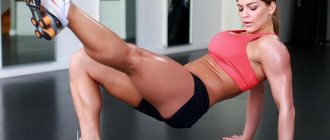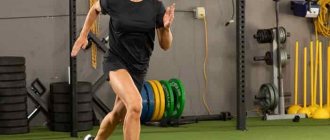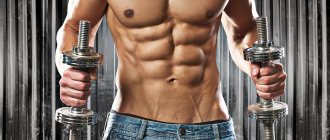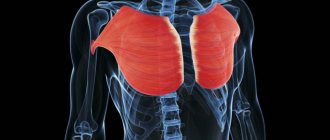We answer one of the most popular questions about amateur sports.
Short answer : You can, but why? If you feel an irresistible urge to go to the gym, at least try not to overload the muscles that have not yet recovered. In addition, you must be sure that the pain is caused by muscle growth and not injury.
Soreness, or delayed onset muscle pain syndrome, is a common condition that athletes typically experience for some time after exercise. For a beginning athlete, discomfort can last up to five to seven days. For an experienced person, muscles usually ache only after super-intense training. Usually pain does not occur immediately: it can only come on the second or third day after training. This is fine.
Why do muscles hurt?
Krepatura is traditionally associated with the accumulation of lactic acid in muscle tissue. In this case, the acid, or rather its breakdown products, is eliminated from the body within a maximum of 72 hours. The causes of further pain are still not fully understood, but most researchers agree that the burning sensation can be caused by damaged cell membranes, which are formed as a result of micro-tears in muscle tissue and are gradually eliminated from the body. In any case, these processes are natural and not dangerous, and therefore in themselves cannot be an obstacle to training.
It should be remembered that muscle pain can also be caused by injuries - sprains or tears. And if an athlete’s pain threshold is high enough, he may not pay attention to this pain. If you see a bruise or swelling on the body, you must stop training, and if necessary, if the swelling does not subside and the pain does not go away for a long time, consult a doctor.
No pain no gain
“No pain, no gain” - this saying has become the motto of bodybuilders. Many bodybuilders take this expression too literally. They try to exercise at maximum intensity in order to get muscle pain after training.
There is still a misconception among gym goers that if muscles hurt the next day after a workout, then this is a 100% guarantee of their further growth.
Such a persistent myth exists, but there is no scientific evidence on this matter. We will find out further what the actual situation is with weight growth and strength.
How to exercise if your muscles hurt?
If there is no injury, but your muscles hurt and you want to train, you should adhere to the following recommendations:
1. Try to alternate workouts on different muscle groups to give them more time to recover.
2. Be sure to do a good warm-up before training. It is important to warm up all muscle groups to reduce pain.
3. If pain prevents you from maintaining correct posture, stretching between workouts will help. If your body still doesn’t listen to you, it’s better to give up training - otherwise you risk getting injured.
4. If the pain doesn't go away within a few days (for example, if you're new, you've had a long break from training, or you've started a new weight program), reconsider your training plan: increasing your training frequency and even lower reps will help.
5. Cooling down and stretching will help reduce the time it takes for lactic acid to be removed from the muscles; devote time to them in the final part of the workout.
6. Pay attention to your diet: prolonged muscle pain may indicate that your body does not have enough nutrients to effectively repair tissue.
And most importantly: remember that pain is not a sign of effective training. If you exercise regularly and eat right, your body will gradually adapt to the stress and the pain will go away. In the future, increase the load gradually, and evaluate the effectiveness of the program according to objective criteria - growth of muscle mass, endurance and reduction of body fat.
Where does the pain come from after training the next day?
Why do muscles hurt after training? Many people mistakenly believe that muscle pain is caused by a buildup of lactic acid, but this is not the case. Muscle pain after physical activity, or delayed onset muscle soreness syndrome, occurs due to microscopic damage. Typically, pain appears after changing the training regimen, increasing physical activity and its intensity.
Severe post-workout pain occurs within 1 or 2 days and usually lasts 3 to 5 days. Of course, muscle pain can be mild - it all depends on the level of difficulty of your last workout.
Delayed muscle pain should not be confused with sharp and sharp pain during exercise - it can be a severe strain or sprain. This kind of pain will not go away on its own.
How to get rid of sore throat and is it necessary to get rid of it? The coach answers
Almost everyone who plays sports has felt terrible at least once in their life after a workout: the body can barely move, the arms can’t lift, everything hurts. This phenomenon is called sore throat. Is it dangerous? How to reduce pain? We asked World Class master trainer Stanislav Vakhrushev
.
What causes sore throat?
If you've ever experienced this unpleasant sensation, you've probably heard that soreness is an indicator of a successful workout. But this is not true at all.
Photo: istockphoto.com
Causes of sore throat:
- first training session;
- adding a new exercise to your workout;
- increasing the intensity of an exercise already included in your program (increasing the amount of weight lifted, repetitions or speed);
- doing the same thing over and over again without taking enough time to rest.
Everyone is at risk for muscle pain, even bodybuilders and other professional athletes. When you exercise, you strain your muscles and the fibers begin to break down. As the fibers repair themselves, they become larger and stronger than before. This means your muscles will be better equipped to handle stress the next time you exercise.
Tomorrow it will hurt: why do your muscles hurt after training?
Is there a way to avoid sore throat?
Before exercising, prepare your body to increase blood flow to your muscles and relax them. This will reduce the risk of injury and help reduce soreness.
Taking breaks between sets is also very important, since decreasing heart rate and breathing gradually lowers body temperature. This will give the muscles time to return to their normal length and increase blood flow, which will help avoid pain.
Photo: istockphoto.com
One of the best ways to prevent sore throat, especially if you are new to exercise, is to begin any new exercise program carefully and gradually. Give your muscles time to adapt to the load. To do this, before the workout, use a treadmill, exercise bike, or any other low-intensity activity.
Stanislav:
After the main warm-up, you need to perform pre-stretching - stretching exercises with a small amplitude, 5-7 seconds for each muscle group. And after the main part of the strength training, it would be useful to perform static stretching exercises - to relax and lower your heart rate!
Massage roller: how to get rid of muscle pain
What to do if pain still appears after strength training?
The worst thing you can do in this case is sit still. Blood carries nutrients and oxygen to muscle tissue. The faster these compounds get to their destination (through the bloodstream), the faster they start working, the faster you will feel better.
This doesn't mean you have to go back to your regular workout routine. Light activity is suitable, at least a walk or stretching exercises.
Photo: istockphoto.com
The key word is “easy”. Stretching is a great way to relieve tension, which can make you feel better, although it won't heal muscle tears or make them recover faster.
Stanislav:
A sauna or bathhouse is perfect for reducing pain. On the third day after workout, you need to do a light aerobic workout so that lactic acid leaves the muscles faster. Low-intensity work - light shaking or random movements of the limbs - will be good for the main part of the workout between strength sets. This will allow lactic acid to leave the muscles faster and prepare you for the next set. Accordingly, recovery will be many times faster and, most likely, this will relieve you of sore throat.
Of course, don't forget about protein. Protein is an essential nutrient for building and maintaining muscle, so it plays a huge role in recovery after a tough workout.
Basic nutrition rules for those who want to pump up
Is it possible to do exercises if the pain has not gone away?
You can exercise with soreness, although it may be uncomfortable at first. The pain will disappear as soon as the muscles warm up. However, most likely, the discomfort will return after exercise, when the muscles cool down.
Photo: istockphoto.com
If you find it difficult to perform the exercises, rest until the pain goes away. Alternatively, you can focus on exercises that target less affected muscles to give the most sore groups time to recover.
Stanislav:
On the third day after strength training, even if soreness occurs, it is simply necessary to exercise. But the load should be low, below average, since low-intensity work will restore muscles faster. Otherwise, the sore throat may last a long time.
Training with muscle pain in practice
To simplify the question, it comes down to whether you can train your muscles every day or often enough. We are, of course, talking about different muscle groups.
Try at least once on Monday, for example, to train your pectorals and triceps, and the next day your back and biceps. We take into account that the load on both of these zones was approximately the same.
The pecs and triceps will start to hurt earlier because they have worked earlier. Back and biceps - later (because their work was a day later). Now watch the speed of recovery: which part of your body will stop hurting first, i.e. will recover faster. This will be the area of the pecs and triceps (after all, they were the first)! Provided that the load was approximately equal on the back and chest.
But if you work out your chest to the fullest, and train your back easily, then perhaps your chest will stop hurting later, even though it was loaded earlier than your back.
As we see from practice (mine and other athletes and coaches), muscle recovery in one part does not slow down, even if another part also requires restoration.
You just need to give enough time for recovery (sleep, rest) and nutrients. If your body has enough of all this, pain in one muscle group will not in any way affect the recovery and growth of another.
And to ensure that you have enough of every BZHU nutrient and calories, you can use our proper nutrition plans. Everything is laid out there: calories are calculated, a menu is drawn up, recommendations and explanations are given for each item.
Is it possible to exercise if the pain has not gone away?
Many people wonder whether it is possible to exercise if the muscles are still sore from the last workout. Soreness is a sign of incomplete recovery after exercise, so full-fledged training remains prohibited.
Acute manifestation of symptoms is a categorical reason to avoid training, and minor discomfort can be eased by light training 1-2 days after the training. Be sure to do a thorough warm-up and then stretch.
The appearance of pain after physical activity is a clear sign of microtrauma, indicating the productivity of the activity. The main condition is the ability to distinguish “bad” pain from “good”. There is no need to be afraid or wait for such sensations and be sure to give your muscles a chance to recover. Exercise is a way to improve your health and work on improving your figure. Don't forget about this and be healthy!
Why can you exercise if your muscles hurt after training?
Some people think that it is impossible to train when the previous muscle group has not yet fully recovered. They say that resources (energy and building materials from food) will already be distributed among several muscle groups, and not just one. And this distribution of resources can lead to under-recovery of both muscle groups at once. Those. type of resources will not be enough, which will reduce the speed of recovery and, in general, because of this, muscles will not grow, strength will not increase, etc. And everything seems to be logical, but in reality things are different.
Firstly
, soreness or delayed onset muscle soreness (DOMS) is not a guarantee of increased muscle size and strength with endurance. Muscles may ache terribly, but not grow, or they may not ache at all and grow by leaps and bounds.
Secondly
, in order to have enough resources to restore several muscle groups at once, you need to eat more. More food = more energy (carbohydrates, fats) and more building materials (protein). And that's definitely enough for you. That's why:
Frequent training increases lean mass. Infrequent - not dry.
What is meant? In short:
1. Frequent workouts
(3-5 or more times a week) lead to the formation of new muscle cells and the growth of existing ones (when the previous muscles have not yet recovered, and we are training the next ones). This collectively leads to muscle growth in general. And the larger the muscle, the stronger and more resilient it is.
Simply put, more frequent training more often triggers the synthesis of new muscle structures. Frequent running = more muscle gain. But! This does not mean that you need to overtrain: rest is no less important than training.
2. Rare workouts
(2 times a week) lead to a greater extent to the growth of energy resources in the cell and to a lesser extent to the formation of new cells. In such cases, we give time for the muscle tissue to fully recover, and only then begin the next lesson. Those. this is largely sarcoplasmic muscle hypertrophy, when not so much the cell itself grows and new ones are formed, but rather it is filled with the nutrients it needs - glycogen, creatine phosphate, etc.
It turns out that the cells increase in size, body weight increases, strength indicators also increase, but in reality this is not an increase in lean muscle mass.
So that there are no questions about how many times to train a week, what exercises to do, what is better for progress - exercise machines or a barbell with dumbbells, use the services of professional trainers who will take care of all the problems and subtleties of building your figure. Why load your head with unnecessary information when there is still so much of it? Just trust our specialists and leave it all to them.











